|
|
  


|
An In Depth Look At The Advantages Of
Crest's Patented Ceramically Enhanced
Transducer Technology
By J.
Michael Goodson, CEO Crest Ultrasonics, Chairman of The Board, The Crest Group
Inc.
Firstly, I feel it would be best to first introduce some of the
results our cermically enhanced transducer technology have fostered in a few of
our client's production environments:
• A disk media
manufacturing facility cut its process time in half and got the cleanest disks
ever.
• Another disk media manufacturing facility improved its yield by 4%.
The equipment pays for itself in 79 days.
• A slider tab application
increased yield to 100%.
• A military application using solvent improved
process time by 40%.
• An Asian solvent/alcohol application for cleaning
& drying produced the highest HSA yield ever recorded, with submicron
specifications.
ABSTRACT:
Our discovery of the
ability to substitute acoustically superior high-tech ceramics for metals in
stacking transducers is perhaps the most important development in ultrasonics in
the last 30 years. The high-tech ceramics transmit sound better than even the
latest state-of-the-art metals used in traditional transducers. Ceramically
stacked high frequency transducers are designed to meet the needs of high-tech
applications where the requirements are submicron cleaning. They offer superior
transmission of sound at higher frequencies which results in better contaminant
removal and reduced damage to sensitive parts. Both general and critical
cleaning applications benefit from this advanced
technology. |
Which Should You Choose?
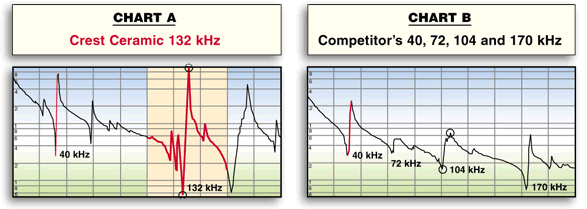
| The superiority of chart A over chart B is clearly
evident. High-tech ceramics make possible the direct stacking of high
frequencies that before were only available as subharmonics of metal stacked
frequencies (which derive their primary power from the weaker first harmonics).
The stacking of a ceramic transducer to the exact frequency results in a
significantly increased level of activity.
Also note that even with a third harmonic direct
stacking, the Crest first harmonic (40 kHz) is stronger than the competitor's
metal stacked 40 kHz.
ADVANTAGES
Ceramics Transmit Sound Better
The acoustical speed at which sound travels through high-tech ceramics
is 63% to 125% greater than aluminum, stainless steel or titanium.
Acoustical Index: The following graph
demonstrates the comparative speed of sound going through metals and
state-of-the-art ceramics. (Acoustical velocity,
mm/microseconds)
|
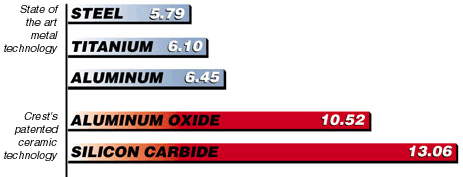
| The problem with traditional metal stacked
transducers is that solid metal is actually made up of strands and strands of
metal, which under high magnification is actually quite porous. In the
transmission of sound waves, the porosity becomes very significant.
High-tech ceramics like alumina oxide and silicon
carbide have a composition of molecules so minute, the porosity is near zero.
Their surfaces are so flat they can be measured in 1,000,000 of an inch. As a
result they offer superior acoustical speed and an improved surface interface.
Thus stacking an ultrasonic transducer with ceramics greatly enhances the
transmission of ultrasonic energy. The near perfect transmission of sound also
reduces the amount of stress involved with transmitting ultrasonic energy,
resulting in increased day-to-day reliability and a much longer trouble-free
life for the system in use.
Stacking Transducers With
Ceramics
Taking into consideration the acoustic
superiority, transmitting sound into the ceramic resonator directly before the
aluminum head mass results in more sound waves being transferred and with
greater intensity.
|

| The ceramic interface allows for the near-perfect
transmission of sound.
Third
Harmonic Frequencies... The Biggest Advantage
What is a third harmonic frequency?
Piezo Ceramic Crystals (PZTs) used for
creating ultrasonic energy are known by their first frequencies, the traditional
Crest 40 kHz PZT for example (see chart 1). Expand the chart and you see an even
stronger third harmonic frequency (chart 2). Looking at the chart's full
spectrum, you will see a number of different harmonics (see chart 3). The
harmonics are based on the number of signals that can be readily identified with
some subjective expectations of strength which makes them useful. High-tech
ceramics make possible the direct stacking of high frequencies that were
previously only available as sub-harmonics of metal stacked frequencies (which
derive their primary power from first harmonics). Third harmonics are always
stronger than first harmonics. Therefore the direct stacking of third harmonics
is highly desirable. Fifth and higher harmonics also offer good potential for
future development.
|
The first harmonic is 40 kHz (Chart 1).
But when you expand the chart, notice
the stronger third harmonic (Chart 2).
|
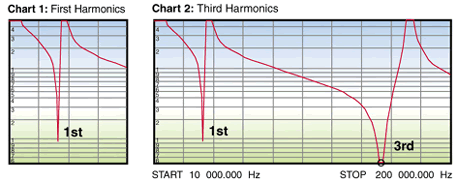 |
If you do a complete scan of the 40 kHz PZT
you can see a total of six (6) strong harmonics, with 40 kHz (the first
harmonic) being the weakest. The advantage of being able to directly stack
harmonics other than the first gives the user of ceramic stacked transducers a
big advantage. Metal stacking works off the weakest harmonics. |
 |
| CONCLUDING STATEMENTS
How Many Third Harmonic Possibilities Are There
For High Frequencies?
Is it possible to
create a third harmonic frequency at any point between 100 and 350 kHz? Yes, you
can create third harmonics up to 500 kHz but it would be cost prohibitive for
the end user, as you go above the 325 to 350 kHz range.
Is The Ceramic 132 kHz The Universal Transducer Of
The Future?
No. It is a great third
harmonic frequency, but with ceramic stacking you have the luxury of having a
family of third and higher harmonics designed to meet specific needs.
|
The Ceramic 200 kHz
This new introduction will challenge the
megasonic frequencies and their modest intensity. Like other third harmonics, it
is extremely intense for such a high frequency. With the ceramic intensity, it
is likely to replace many of the megasonic units on the market. Reliability:
Using the Martin Walter power supply we expect the transducers to last for
several years compared to most megasonic transducers' life expectancy of 6 to 12
months. |
|
|
How Reliable Are Ceramic
Transducers?
After more than 18 months
since its introduction, and with more than 75 ceramic 132 kHz systems installed
world wide, not one single generator/transducer installation failure has been
reported anywhere in the world. It seems unbelievable, but it is true. This
reliability can be directly attributed to the enhanced efficiency of
transmitting ultrasonic sound waves using high-tech ceramics and
state-of-the-art Martin Walter AG power supplies to power the transducers.
|
|
RIGIBOT AUTOMATION SYSTEMS NOW FEATURE THE EXCLUSIVE SAFETY ARM TRIGGER
SWITCH ASSEMBLY
|
|
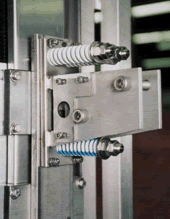
Omni-directional
force detection
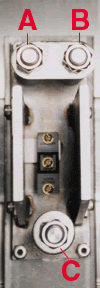
|
안전 보호 장치
: Rigibot은 바스켓에 피세척물을 담아 상하 좌우로 움직일 수
있으며 Safety Arm Trigger Switch Assembly는 일종의 Interlock
장치입니다.
예를 들면 Rigibot이 바스켓을 들고 좌로
움직이다가 심한 저항을 받거나 뜻하지 않은 장에물에 부딪쳤을
때 움직임이 바로 STOP할 수 있게 만든 안전 장치 입니다.
안전보호
장치 (English) : Due to the variables of human
error, it's impossible to eliminate this type of occurrence altogether, so the
technical strategy is to greatly minimize the damage of impact. Our remarkable safety arm trigger switch is designed to
detect force that results from arm contact with an obstacle, and to signal the
PLC to stop the Rigibot immediately so that a correction can be made. Force
detection is omni-directional, which means that contact with virtually all
obstacles will be detected.
|

|


